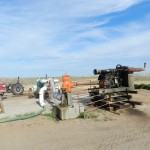
Some call it, “he said, she said,” journalism. Others call it “fair and balanced.” Whatever the name, the journalistic practice of giving equal weight to “both sides” of an issue has become a pernicious enemy of truth.
Just consider the Modesto Bee’s July 28 interview with Sean Roddy of Henning Bros. Drilling Company. Roddy has drilled many of the new wells on Stanislaus County’s east side. Nonetheless, in response to the Bee’s question whether the drilling or weather conditions were responsible for the falling water table, Roddy said, “There’s no way to say absolutely,’” why the water table is dropping.
Given the hundreds of new wells and tens of thousands of acres of new almond orchards in eastern Stanislaus County, Roddy’s statement is demonstrably false. In fact, it’s much like drinking a glass of water and saying there’s no way to know why the water’s gone.
In the name of “objectivity,” too many journalists today are willing to print falsehoods. What emerges is a pattern that dismisses facts and science as materially equivalent to partisan denial and wishful thinking.
Roddy also said that, “If we had gotten more than normal snowfall,” there wouldn’t be a problem with groundwater on the County’s east side. Again, the statement is demonstrably false.
There have been many, many, years of more than normal snowfall in the Sierra Nevada east of the San Joaquin Valley, and many years of above average rainfall. Nonetheless, the aquifer in many parts of the Valley has been depleted to the point of no return.
The point of no return is reached when subsidence and compaction, both of which result from over drafting, result in “perched water.” Perched water is water that can’t penetrate compacted soil and thus can’t recharge the aquifer. The area from Los Banos to Kettleman City features the largest known area of extreme subsidence in the world.
And while it may takes decades or even hundreds of years to fill an extensive aquifer, it takes only a generation or two to deplete it. Just consider the Ogallala aquifer, which in some places has dropped more than 150 feet since the 1950s.
There’s nothing more mysterious about dropping water tables than there is about empty water glasses. Remove more from the aquifer than gets replaced, and the water table drops. That pattern is a material and historical fact, verified again and again right here in the San Joaquin Valley and many other places.
When the Bee prints disinformation like that in the interview with Sean Roddy and in a recent Community Column by Mike Romeo, it does a great disservice to Valley citizens seeking the truth about water issues in the San Joaquin Valley.
Bee readers deserve to know the facts about water in their region, and there is plenty of historical and scientific evidence to draw on. As the only major print medium for local news in the region, the Bee should eschew false equivalencies brought about by “he said, she said” journalism in favor of facts and truth.
